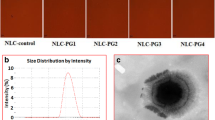Abstract
Attempts to improve low absorption and rapid metabolic conversion of curcumin were made by developing curcumin-loaded bilayer nanoliposomes coated with chitosan and alginate for intestinal-specific drug delivery. A curcumin-loaded nano-liposome was prepared with optimized formulations with phosphatidylcholine, curcumin, chitosan, and alginate. The particle size of the optimized formulation was approximately 400 nm, and the encapsulation efficiency was more than 99%. In the in vitro release study, curcumin release from the curcumin-loaded nanoliposome with double layers of chitosan/alginate (CNL-CH/AL) was suppressed in the simulated gastric fluid (SGF, pH 1.2) and enhanced in the simulated intestinal fluid (SIF, pH 6.8). In the in vivo pharmacokinetic study in rats, the CNL-CH/AL-treated group showed a prolonged absorption pattern of curcumin and the area under the plasma concentration–time curve from 0 to 24 h (AUC0–24) was improved 109-fold compared to the control group treated with a curcumin solution without a nanocarrier.



Similar content being viewed by others
References
Amidon S, Brown JE, Dave VS. Colon-targeted oral drug delivery systems: design trends and approaches. AAPS PharmSciTech 16:731-741 (2015)
Anand P, Kunnumakkara AB, Newman RA, Aggarwal BB. Bioavailability of curcumin: Problems and promises. Molecular Pharmaceutics 4:807-818 (2007)
Antunes AH, Faria FR, Mota JF, Santiago MF, Kogawa AC, Rezende KR. Bioanalytical method by HPLC-FLD for curcumin analysis in supplemented athletes. Saudi Pharmaceutical Journal. 28: 599-606 (2020)
Berger J, Reist M, Mayer JM, Felt O, Gurny R. Structure and interactions in chitosan hydrogels formed by complexation or aggregation for biomedical application. European Journal of Pharmaceutics and biopharmaceutics. 57:35-52 (2004)
Bisht S, Maitra A, Systemic delivery of curcumin: 21st century solutions for an ancient conundrum. Current Drug Discovery Technologies. 6:192-199 (2009)
Catalan-Latorre A, Ravaghi M, Manca ML, Caddeo C, Marongju F, Ennas G, Escribano-Ferrer E, Esteban Peris J, Diez-Sales O, Maria Fadda A, Manconi M. Freeze-dried eudragit-hyaluronan multicompartment liposomes to improve the intestinal bioavailability of curcumin. European Journal of Pharmaceutics and Biopharmaceutics. 107:49-55 (2016)
Chen-yu G, Chun-fen Y, Qi-lu L, Qi T, Yan-wei X, Wei-na L, Guang-xi Z. Development of a quercetin-loaded nanostructured lipid carrier formulation for topical delivery. International Journal of Pharmaceutics. 430:292-298 (2012)
Date T, Paul K, Singh N, Jain S. Drug lipid conjugates for enhanced oral drug delivery. AAPS PharmSciTech. 20:41 (2019)
Dutta AK, Ikiki E, Novel drug delivery systems to improve bioavailability of curcumin. Journal of Bioequivalence & Bioavailability. 6: 1 (2013)
Gierszewska M, Ostrowska-Czubenko J, Chrznowska E, pH-responsive chitosan/alginate polyelectrolyte complex membranes reinforced by tripolyphosphate. European Polymer Journal. 101: 282-290 (2018).
Hao J, Guo B, Yu S, Zhang W, Zhang D, Wang J, Wang Y. Encapsulation of the flavonoid quercetin with chitosan-coated nano-liposomes. LWT-Food Science Technology. 85: 37-44 (2017)
Jeffrey B, Fritz M, Brender JF, Smith PES, Lee DK, Ramamoorthy AJ. Solid-state NMR reveals the hydrophobic-core location of Poly(amidoamine) dendrimers in biomembranes. Journal of the American Chemical Society. 132: 8087-8097 (2010)
Jing H. Sun J. Mu Y. Obadi M. McClements DJ. Xu B. Sonochemical effects on the structure and antioxidant activity of egg white protein-tea polyphenol conjugates. Food and Function 11: 7084-7094 (2020)
Li N, Zhuang C, Wang M, Sun X, Nie S, Pan W. Liposome coated with low molecular weight chitosan and its potential use in ocular drug delivery. International Journal of Pharmaceutics. 379: 131-138 (2009)
Li C, Zhang Y, Su T, Feng L, Long Y, Chen Z. Silica-coated flexible liposome as a nanohybrid delivery system for enhanced oral bioavailability of curcumin. International Journal of Nanomedicine. 7: 5995-6002 (2012)
Liu Y, Liu D, Zhu L, Gan Q, Le X, Temperature-dependent structure stability and in vitro release of chitosan-coated curcumin liposome, Food Research International. 74:97-105 (2015)
McClements DJ, Peng SF. Current status in our understanding of physicochemical basis of bioaccessibility. Current opinion in Food Science. 31:57-62 (2020)
Pathak L, Amrutanand T, Agrawal Y. Alginate-chitosan coated lecithin core shell nanoparticles for curcumin: Effect of surface charge on release properties and biological activities. Indian Journal of Pharmaceutical Education and Research. 51(2): 270-279 (2017)
Salehi B, Antidiabetic potential of medicinal plants and their active components. Biomolecules. 9: 551 (2019)
Sasaki H. Sunagawa Y, Takahashi K, Imaizumi A, Fukuda H, Hashimoto T, Wada H, Katanasaka Y, Kakeya H, Fujita M, Hasegawa K, Morimoto T. Innovative preparation of curcumin for improved oral bioavailability. Biological and Pharmaceutical Bulletin. 34(5): 660-665 (2011)
Shin GH, Chung SK, Kim JT, Joung HJ, Park HJ. Preparation of chitosan-coated nanoliposomes for improving the mucoadhesive property of curcumin using the ethanol injection method. Journal of Agriculture food Chemistry. 61: 11119-11126 (2013).
Zheng B, McClements DJ. Formulation of more efficacious curcumin delivery systems using colloid science: Enhanced solubility, stability, and bioavailability. Molecules. 25: 2791 (2020)
Funding
This research was supported by Regional Specialized Industry Development Plus Program (R&D, S3245916) funded by the Ministry of Small and Medium-sized Enterprises and Startups of Korea.
Author information
Authors and Affiliations
Corresponding author
Ethics declarations
Conflict of interest
None of the authors of this study has any financial interest or conflict with industries or parties.
Additional information
Publisher's Note
Springer Nature remains neutral with regard to jurisdictional claims in published maps and institutional affiliations.
Rights and permissions
Springer Nature or its licensor (e.g. a society or other partner) holds exclusive rights to this article under a publishing agreement with the author(s) or other rightsholder(s); author self-archiving of the accepted manuscript version of this article is solely governed by the terms of such publishing agreement and applicable law.
About this article
Cite this article
Jang, GH., Kim, YM., Kim, DH. et al. A chitosan/alginate coated nano-liposome to improve intestinal absorption of curcumin for oral administration. Food Sci Biotechnol 33, 1707–1714 (2024). https://doi.org/10.1007/s10068-023-01461-4
Received:
Revised:
Accepted:
Published:
Issue Date:
DOI: https://doi.org/10.1007/s10068-023-01461-4




